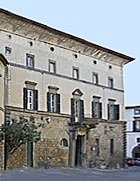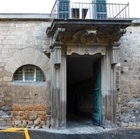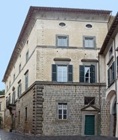


n 1548, Cardinal Girolamo Simoncelli built a palace here on the site of houses that had belonged to the Filippeschi family. It probably took on its present form after it passed to Caravajal dei Caravajal-Simoncelli, Bishop of Sovana (1535-96), at which point it became known as Palazzo Carvajal.

-
✴An inscription to the left of the frieze below the first floor windows announces in Spanish that Carvajal des Carvajal built the palace for the convenience of his friends.
-
✴Another in Latin over the portal states that it is open for good, not for evil.
The palace is often attributed to Ippolito Scalza; however, Augusto Roca de Amicis (referenced below) suggests that his hand can only be easily recognised in the main portal.
The palace passed to the Pietrangeli family in 1807. It is now called Palazzo del Cardinale, and offers B&B accommodation.
Oratorio di San Sabino (1571)

-
✴that it housed a “decorosissima tavola” (very decorous panel) dated 1473, which was attributed to Giovanni Boccati (see below); and
-
✴that a high tower near the palace that was known as the Torre di San Sabino had collapsed in 1616 (in the reference below, at p 27).
The portal in the north wall of the palace probably belonged to this oratory.
St Sabinus Altarpiece (1473)
As noted above, this altarpiece, which is dated by inscription, was documented in the Oratorio di San Savino in Palazzo Carvajal (which was then called Palazzo Pietrangeli) in 1829, and was first attributed to Giovanni Boccati in 1866. A document in the archives of Orvieto records that Antonio Simoncelli made a payment to Giovanni Boccati in 1473, and this almost certainly relates to this altarpiece.
The altarpiece was placed on the art market in Florence in 1895.
-
✴The main panel and the original frame (minus the predella panel) were sold to the Szpmvszeti Muzeum (Museum of Fine Arts), Budapest.
-
•The panel itself depicts the Madonna and Child enthroned, with SS Juvenal, Sabinus of Canosa, Augustine and Jerome, against a gold background. There are two standing angels on each side of the Madonna, and two sit on the marble pavement at her feet, playing stringed instruments. The face of the Madonna seems to have been repainted later in the 15th century, perhaps by Antonio del Massaro da Viterbo, il Pastura.
-
•The upper cornice of the frame contains three painted angels with garlands, and there is a figure of Christ the Redeemer in the lunette above.
-
✴The predella panels depict four scenes from the life of St Sabinus:
-
•St Sabinus talking to his friend, St Benedict on Monte Cassino about Totila's entry into Rome (now in the Museo Thyssen-Bornemisza, Madrid);
-
•St Sabinus recognises Totilla (once in the Mario Lanfranchi collection, Rome);
-
•the Archdeacon Vindemius attempts to poison St Sabinus (now in the Galleria Nazionale, Urbino); and
-
•death of St Sabinus (once in the Spiridon collection, Paris).
There is some confusion as to the original location of the altarpiece:
-
✴Some sources indicate that it came a chapel in the Duomo that was dedicated to St Sabinus of Canosa, but there is no record that any such chapel ever existed.
-
✴More recent scholars suggest that it was painted for the Oratorio di San Savino in Palazzo Carvajal. Cardinal Girolamo Simoncelli, the son of Antonio Simoncelli, built the palace in 1548, and Caravajal dei Caravajal-Simoncelli built the oratory in 1571. It is possible that an earlier palace and oratory on this site belonged to the Simoncelli family at the time that the altarpiece was commissioned.
-
✴A more likely candidate for its original location seems to me to be San Giovenale, near Palazzo Carvajal, given that:
-
•the altarpieces features St Juvenal as well as St Sabinus;
-
•San Giovenale contained relics of St Sabinus and was documented as SS Giovenale e Sabino in 1314; and
-
•St Sabinus features in a number of other works in the church; and
-
•one of the above is a second altarpiece (ca. 1490) with the Madonna and Child enthroned an SS Juvenal, Sabinus of Canosa, with three scenes from the life of St Juvenal in its predella .
-
It is possible that Antonio Simoncelli commissioned the altarpiece for the church, and that it reverted to his descendants before 1807, when Palazzo Carvajal was sold to the Pietrangeli family.
Read more:
A Roca de Amicis, “Palazzo Carvajal, Orvieto”, in
A. Cambareri and A Roca de Amicis, “Ippolito Scalza (1532-1617)”, (2002) Perugia, 178-9
M. Minardi, “Giovanni di Pier Matteo Boccati” in
A. De Marchi (Ed.), “Pittori a Camerino nel Quattrocento” (2002) Jesi, pp 283-8, catalogue items 27-31
P. Perali, “Orvieto: Note Storiche di Topografia e d' Arte, dalle Origini al 1800” (1891) Città di Castello (reprinted in 1979)
Return to Monuments of Orvieto.
Return to Walk II.

